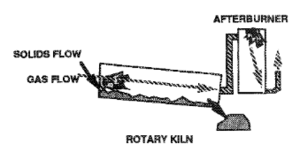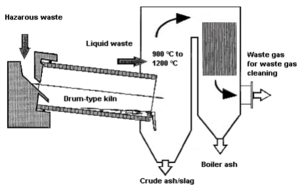Rotary Kiln
Rotary kilns are very robust and are often used in solid/liquid waste incineration due to its versatility to treating a wide range of feedstocks from slurries (wet process) through to dry materials (dry process) and hazardous waste at high temperatures. The kiln is a continuous counter current reactor which consists of a long tube that is positioned at an angle near horizontal and is rotated. The angle and rotation allow feedstock to work its way down the tube and dictate their retention time in the kiln. Gas is passed through the tube counter current to the solid reactant[1].
The Process

A typical rotary kiln incineration unit consists of two elements: the rotary kiln and the afterburner/secondary combustion chamber. The feedstock enters the vessel which is positioned longitudinally approximately 5-30° of the horizontal position and located on rollers to ensure continuous motion of catalyst. The kiln contains a burner which is fired axially either in the same direction as the solids (co-flow) or the opposite direction (counter flow) to achieve good waste burnout. The residence time of the waste in the kiln is between 30 to 90 minutes. The afterburner/secondary combustion chamber maintains high temperature to destroy the more stable hazardous flue gases (especially for incinerations of hazardous wastes) and the ash/slag is released[2].
Types of Waste Treated
Rotary kilns are very robust and almost any waste, regardless of type and composition, can be incinerated. Kilns are widely used for the incineration of hazardous wastes and most hazardous clinical waste is incinerated in high temperature rotary kiln incinerators. Solid, liquid and gaseous wastes as well as sludges can be incinerated in rotary kilns. Solid materials are fed through a non-rotating hopper, liquid waste is injected into the kiln through burner nozzles and pumpable waste and sludges are injected into the kiln via water-cooled tubes[1].
Operating Temperature
Operating temperatures of rotary kilns range from 500°C (as a gasifier) to 1450°C (as a high-temperature ash melting kiln). When used for conventional combustion, the kiln temperature is generally higher than 850°C and temperatures range from 900°C to 1200°C when incinerating hazardous wastes. Generally, and depending on the waste input, the higher the temperature, the greater the risk of fouling and thermal stress damage to the refractory kiln lining[1].
Water Cooling
Water cooling is usually used together with higher temperature kilns. The rotary kiln water cooling system consists of two cooling circuits:
- The primary cooling water circuit delivers primary cooling water on top of the rotary kiln and distributes it evenly to guarantee an equal cooling effect over the whole shell of the kiln. Water is then collected and flows into the water collection tank. Water is circulated back through a filter and a heat exchanger with a circulation pump.
- The secondary circuit removes heat from the primary circuit through heat exchangers and transfers it for use.
The system delivers cooling water through hundreds of spray nozzles situated all over the shell of the kiln, keeping the temperature of the shell at 80–100 °C, whereas for air cooling the steel shell temperature is typically a few hundred degrees higher[1].
Types of Rotary Kiln
Rotary kilns can be classified into two general types: direct fire and indirect fire.
Direct Fire
The direct fire kiln is a single shell vessel with rings added inside to slow the catalyst as it tumbles from the inlet (elevated part) towards outlet (lower part). The oxidation medium (air) flows counter current to catalyst movement. The oxygen concentration in the medium will decrease in the same direction because of its consumption. Therefore, the zone in the vessel located near the inlet may function as a stripper of volatile components of coke. The kiln is fired by gas burners directly against the outer shell of the vessel. The temperature inside the kiln is controlled by adjusting the burner heat, varying concentration of oxygen in the oxidizing medium (air) and its flow.
Indirect Fire
The indirect fire kiln comprises a double-shell cylinder vessel. The inner shell is similar as that of the direct fire kiln. The space between the shells is heated either by combustion gas or steam. In some cases, the inner cylinder shell is ebullated (fluidised by the continual injection of gas and liquid) allowing hot gases or steam to enter and contact the tumbled catalyst. The catalyst temperatures are controlled by monitoring the temperatures of the inlet and outlet gases. [3]
Rotary Kiln with a Post-Combustion Chamber for Hazardous Waste Incineration

A combination of rotary kilns and post-combustion chambers has proven successful for incineration of hazardous waste as this combination can treat solid, pasty, liquid and gaseous wastes uniformly. The kiln operating temperature is usually between 850 °C and 1 300 °C. The temperature can be maintained by burning higher calorific (e.g. liquid) waste, waste oils, heating oil or gas. Operation at higher temperatures may result in molten (vitrified) bottom ash (slag), whilst at lower temperatures the bottom ashes are sintered (solidify).
Rotary kilns are tilted towards the post-combustion chamber. This along with the slow rotation (between 3-40 rotations per hour), facilitates the transport of solid hazardous wastes that are fed into the upper end, as well as the bottom ash produced during incineration, in the direction of the post-combustion chamber. These are then removed together with the ash from the post-combustion chamber via a wet bottom ash discharger. The residence time for solid wastes is typically greater than 30 minutes.
A post-combustion chamber is usually used to increase the disintegration of toxic compounds. Additional firing using liquid waste/support fuel may be carried out to maintain the temperatures required to ensure the complete destruction of compounds in the exhaust gas. The post-combustion chamber provides the necessary time for the incineration of the flue gasses produced in the kiln, as well as for the incineration of directly injected liquid and gaseous wastes. Due to the high temperatures (900-1200°C) and the secondary air introduction in the post-combustion chamber, the combustion of the exhaust gases is completed, and organic compounds are destroyed. [1]
